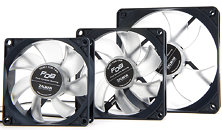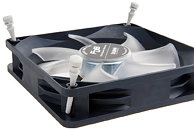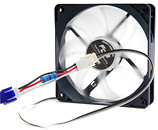- Joined
- Oct 9, 2007
- Messages
- 47,684 (7.42/day)
- Location
- Dublin, Ireland
| System Name | RBMK-1000 |
|---|---|
| Processor | AMD Ryzen 7 5700G |
| Motherboard | Gigabyte B550 AORUS Elite V2 |
| Cooling | DeepCool Gammax L240 V2 |
| Memory | 2x 16GB DDR4-3200 |
| Video Card(s) | Galax RTX 4070 Ti EX |
| Storage | Samsung 990 1TB |
| Display(s) | BenQ 1440p 60 Hz 27-inch |
| Case | Corsair Carbide 100R |
| Audio Device(s) | ASUS SupremeFX S1220A |
| Power Supply | Cooler Master MWE Gold 650W |
| Mouse | ASUS ROG Strix Impact |
| Keyboard | Gamdias Hermes E2 |
| Software | Windows 11 Pro |
Zalman has started shipping its newest low-noise case fans, the ZM-Fx-FDB series (where "x" is 1,2,3, representing 80 mm, 92 mm, 120 mm, respectively). The fan uses three means to lower noise output: a PWM-based speed control, silicone pins that attach it to the case instead of metal screws, and fluid-dynamic bearing (FDB) that has a long life and makes low noise. The FDB ensures the fan has a service life of 150,000 hours. The impeller is made of translucent (frost) plastic, though it isn't LED-lit. A low-noise speed mode can be selected by placing the provided resistor.
The ZM-F1-FDB spins at 1,400~2,000 rpm with 18~23 dBA noise output, ZM-F2-FDB at 1,300~2,000 rpm with the same 18~23 dBA noise, and ZM-F3-FDB at 1,000~1,500 with 18~23 dBA noise as well. With the ZM-RC56 resistor in place, the fans spin at a lower speed, with a constant noise output of 18 dBA. While the ZM-F2-FDB is due for market release on the 25th of September, the ZM-F1-FDB is priced at 7.9 EUR, and ZM-F3-FDB at 9.5 EUR.



View at TechPowerUp Main Site
The ZM-F1-FDB spins at 1,400~2,000 rpm with 18~23 dBA noise output, ZM-F2-FDB at 1,300~2,000 rpm with the same 18~23 dBA noise, and ZM-F3-FDB at 1,000~1,500 with 18~23 dBA noise as well. With the ZM-RC56 resistor in place, the fans spin at a lower speed, with a constant noise output of 18 dBA. While the ZM-F2-FDB is due for market release on the 25th of September, the ZM-F1-FDB is priced at 7.9 EUR, and ZM-F3-FDB at 9.5 EUR.



View at TechPowerUp Main Site






 I changed my explanation to not say 'Digital' motor since, I don't believe, that is correct. I am no motor expert by any means, but motors are mostly understood as being analog but have a functional operation range (voltage range) that can be used to drive the motor. If you go below this operating range the motor simply will not spin, which can be 'somewhat' viewed as digital in nature. So the question that might come up is, why use a digital technique on an analog component? I think the answer here is that it is more energy efficient, since you are only supplying power part of the time rather than 100% of the time...I could be wrong on this though.
I changed my explanation to not say 'Digital' motor since, I don't believe, that is correct. I am no motor expert by any means, but motors are mostly understood as being analog but have a functional operation range (voltage range) that can be used to drive the motor. If you go below this operating range the motor simply will not spin, which can be 'somewhat' viewed as digital in nature. So the question that might come up is, why use a digital technique on an analog component? I think the answer here is that it is more energy efficient, since you are only supplying power part of the time rather than 100% of the time...I could be wrong on this though.
